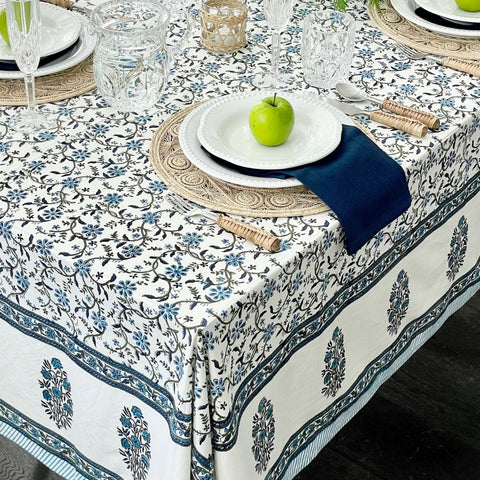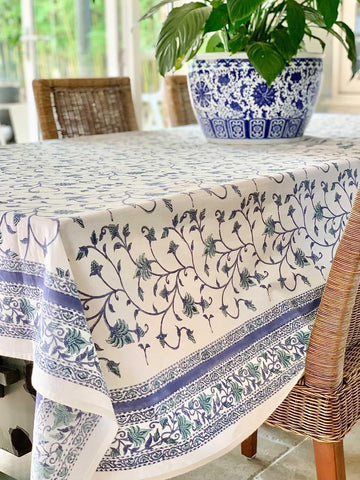Free standard domestic shipping from Queensland across Australia. 30-day returns.
For delivery to the USA and Canada, click here
Free standard domestic shipping from Queensland across Australia. 30-day returns.
For delivery to the USA and Canada, click here
What Tablecloth Material is the Best? Cotton vs Linen and Other Materials
January 31, 2023 6 min read 1 Comment
"Be able to set a table so that you feel like you're dining instead of just sitting and eating."
-Marilyn vos Savant
Have you ever stopped and wondered why tablecloths are used at all? A little-known fact is that they weren't originally designed to be used as stunning decorative pieces. Table cloths were actually meant to protect furniture from scratches, dust and other general wear and tear. However, over the centuries, tablecloths have evolved into an important element of dining etiquette.
If you're thinking of buying a tablecloth to protect your table while presenting food at a party, choosing a material and style can be confusing. As with most things, you get what you pay for, so it's worthwhile to invest in the best quality tablecloth for your needs.
When it comes to table linens, there are so many options available, that you might feel overwhelmed. Cotton, linen, polyester, satin and vinyl are the most common materials used to make tablecloths. While each material has its own inherent qualities that make it unique from the others, you may be surprised to know how easy it is to find a good quality tablecloth at an affordable price. Which is the best fabric for tablecloths? That's an important question, so I'm glad you asked! Let's put all of the fabrics discussed in this article to the test and find out which WINNER is at the top.
Difference Between Cotton and Linen for Tablecloths
Both cotton and linen are durable, breathable, soft fabrics derived from natural fibres. Both are amongst the oldest fabrics known to humans, and in use for thousands of years now. So where do they differ?
Let’s take a closer look at that :
1) Origin
Cotton is one of the most widely produced natural fibres in the world. The fibres come from cotton plants whose seed pods are filled with clumps of fibre in a ball-like shape. The cotton plants are grown in warm-climate nations such as the United States, China, India, Brazil, and Turkey.
Linen fibres, on the other hand, are derived from flax plant stems and are recognised for their exceptional durability and sustainability. Flax plants are grown in countries with cold climates like France, Belgium, Italy, Ireland, China, and the United States.
2) Environmental impact
According to a study published in The Guardian, tests conducted on washing machines estimated that a single item of clothing can release millions of fibres during a normal domestic wash. That, as a result, causes several million metric tons of plastic fibres to find their way each year directly into oceans, where they are broken down into microscopic bits over time. Clothes made of synthetic fibres hence end up polluting the oceans.
Adding to this, it was suggested that choosing products made with more environment-friendly fabrics, like cotton and linen can help you prevent pollution. You can also install lint traps on your washing machines to minimise the environmental impact.
Cotton and Linen are both made of fibres that come directly from plants. These fibres are biodegradable and do not pollute the water like synthetic fibres do. So from an environmental point of view it is certainly better to use natural fibres like cotton and linen.
3) Usage
Cotton is widely used for tablecloths all over the world. It is a soft natural fibre that receives its strength by being spun into yarn and then woven into fabric. It's soft, easy to iron,easy to clean and mostly machine washable. Cotton is also the preferred fabric for table napkins. Though cotton tablecloths are suitable for outdoor use, prolonged exposure to extreme weather and moisture can cause them to mould and the colours to get lighter.
Linen fabric is pricier than cotton. It takes more effort to process and it also requires more care when washing. For making tablecloths, linen is usually blended with cotton. This makes it easier to iron and more affordable.
Bonus: Once worn out with usage, both cotton and linen tablecloths can be cut and reused as cleaning cloths around the house. They have good absorbent properties and are ideal for household cleaning.
4) Texture & Appearance
Cotton has a smoother texture. It is also soft to touch and does not irritate the skin. That’s exactly why cotton is frequently used for baby bedding sets. Linen , on the other hand, has a rougher, textured pattern due to the looser weave.
Linen tends to be a bit more coarse as well. It is widely used in apparel and has a distinct look and feel to it. It tends to get softer with every wash though.
For tablecloths, texture is not of the same importance as it may be for bedding and clothing. However, pure linen wrinkles more than pure cotton and this can be an important factor in choosing one over the other for tablecloths.
5) Durability
Both of them are very durable fabrics. Cotton offers a bit more elasticity and flexibility than linen. Long-staple cotton fibres are used to create finer cotton, such as Egyptian cotton, which makes it softer and more durable than normal cotton.
However, you can get higher thread counts in linen than cotton without sacrificing durability.
6) Colour Retention
Both cotton and linen take on easily to dyes and can be dyed in a multitude of colours.
Tablecloths made out of cotton and linen are high-quality and retain colour very well even after many washes. Also, you can wash them either in the washing machine or dry-clean – both ways are fine and will not damage your tablecloth.
The Indian block print industry has been using cotton fabric for centuries and continues to this day. From tablecloths to apparel, cotton fabric has been a mainstay in the handmade block printing industry. Have a look at our collections to get an idea of the range of colours that these cotton tablecloths come in.

Indian Block print cotton tablecloth
7) Breathability
Cotton and linen fabrics are both breathable, and skin-friendly. They both provide a feeling of comfort and are soft to the touch.
The flax linen fibres are hollow, allowing air and water to flow freely, but the breathability of linen depends on weather conditions due to its thickness.
Linen clothing is better suited in humid conditions, whereas cotton can be worn all year round. This ,however, is not too important when deciding between cotton and linen tablecloths.
8) Wash and care
Caring for both cotton and linen fabrics is fairly easy. It's usually safe to machine-wash most linen and cotton, but we highly recommend checking the brand care labels first. Special care may be required for certain details, such as embellishments, dyes ,prints etc.
It is important to always pre-treat stains. It's easier to remove them when they're fresh, so treat any gravy or wine splatters right away. Both fabrics should be washed in cold or warm water, but never hot water, as it may cause heavy shrinking and colour fading etc. Expect some shrinking even in cold/ warm water.
For the best finish, iron the reverse side of the dampened fabric. If necessary, use steam and spray to remove wrinkles and creases.

Cotton vs. Other Materials
Polyester:
Polyester has a somewhat silkier and shinier look than cotton, making it more ideal for more formal occasions such as weddings or birthday celebrations. However, polyester is composed of chemicals, so some people are allergic to it.
Vinyl:
Though Vinyl is impervious to stains, light, water, and air exposure, they may not be appropriate for formal weddings or parties, because vinyl tablecloths are often associated with casual and outdoor dining.
Silk and Satin:
Satin tablecloths can be made of silk or synthetic materials like polyester, but the most frequently available satin textiles are made of polyester, as real silk is expensive.
So what makes you choose one over another for your table linens? Is it the cost? Or texture ? Or the environmental effects ?
Cotton tablecloths are sturdy, which makes them perfect for everyday use. They are also affordable, available in a variety of colours, and are easy to clean. On the other hand, linen tablecloths have a soft texture that gives them a more luxurious look. While they are more expensive than cotton, they do have their own advantages as discussed above.
Takeaway : There are pros and cons to each type of table cover, and the best choice depends on your personal preference, but if you ask us, you can’t go wrong with natural fibres. They are environment friendly and last long with good care.
Conclusion :
Cotton and linen home wares are having a moment. Whether you choose subtle, neutral or vibrant colour bursts, they both look great. And owing to their longevity, they will continue to look and feel wonderful for years to come.
So, are you on the same page as us when it comes to the cotton vs. linen debate? What is it about these wonderful fabrics that you find so appealing? Do let us know in the comments below.
We at Decor Mantra stock 100% premium cotton tablecloths. Explore our range here
1 Response
Leave a comment
Comments will be approved before showing up.


Ann sharkey
September 26, 2025
Wanting to buy Material to make round tablecloths. Can you help please?